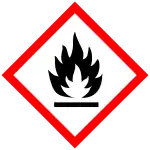Azomethan
Azomethan ist ein farbloses bis schwach gelbliches explosives Gas und die einfachste organische Azoverbindung.
| Strukturformel | ||||||||||||||||
|---|---|---|---|---|---|---|---|---|---|---|---|---|---|---|---|---|
-Azomethane.svg.png.webp) | ||||||||||||||||
| cis- (oben) bzw. trans-Azomethan (unten) | ||||||||||||||||
| Allgemeines | ||||||||||||||||
| Name | Azomethan | |||||||||||||||
| Andere Namen |
| |||||||||||||||
| Summenformel | C2H6N2 | |||||||||||||||
| Kurzbeschreibung |
farbloses bis schwach gelbes Gas[1] | |||||||||||||||
| Externe Identifikatoren/Datenbanken | ||||||||||||||||
| ||||||||||||||||
| Eigenschaften | ||||||||||||||||
| Molare Masse | 58,082 g·mol−1 | |||||||||||||||
| Schmelzpunkt | ||||||||||||||||
| Siedepunkt | ||||||||||||||||
| Dampfdruck |
1001 hPa (trans, 0 °C)[3] | |||||||||||||||
| Sicherheitshinweise | ||||||||||||||||
| ||||||||||||||||
| Soweit möglich und gebräuchlich, werden SI-Einheiten verwendet. Wenn nicht anders vermerkt, gelten die angegebenen Daten bei Standardbedingungen. | ||||||||||||||||
Gewinnung und Darstellung
Azomethan lässt sich aus 1,2-Dimethylhydrazin durch vorsichtige Oxidation, beispielsweise mit Kupfer(II)-chlorid, in guter Ausbeute herstellen.[5]
Eigenschaften
Von Azomethan existieren zwei Isomere:
- cis-Azomethan, nach IUPAC: (Z)-Azomethan
- trans-Azomethan, nach IUPAC: (E)-Azomethan.
Das trans-Isomer ist um 42 kJ/mol stabiler als die cis-Verbindung.[6] Bei Temperaturen oberhalb von 0 °C tautomerisiert Azomethan zu Formaldehyd-N'-methylhydrazon (CH3NHN=CH2).[7]

Verwendung
Die schwierige Handhabung der Verbindung steht einer größeren technischen Anwendung entgegen. Im Labor kann Azomethan zur Erzeugung von Methylradikalen verwendet werden.[8] Bei der Pyrolyse bilden sich neben dem thermodynamisch sehr stabilen Stickstoff kurzzeitig zwei Methylradikale.
Biologische Bedeutung
Beim Metabolismus des stark krebserregenden 1,2-Dimethylhydrazin entsteht Azomethan durch Oxidation in der Leber als Zwischenprodukt.[9]
Literatur
- K. Wolter: Schwingungsspektroskopische Untersuchungen an einem Übergangsmetalloxid/Metall-Modell-Katalysatorsystem. Dissertation, TU Berlin, 2001, urn:nbn:de:kobv:83-opus-3167.
- K. S. Khuong und K. N. Houk: One-bond, two-bond, and three-bond mechanisms in thermal deazetizations of 2,3-diazabicyclo[2.2.2]oct-2-enes, trans-azomethane, and 2,3-diazabicyclo[2.2.1]hept-2-ene. In: Journal of the American Chemical Society. Band 125, 2003, S. 14867–14883, PMID 14640664.
- E. W. Diau und A. H. Zewail: Femtochemistry of trans-azomethane: a combined experimental and theoretical study. In: ChemPhysChem. Band 4, 2003, S. 445–456, PMID 12785258.
- P. Cattaneo und M. Persico: Semiclassical simulations of azomethane photochemistry in the gas phase and in solution. In: Journal of the American Chemical Society. Band 123, 2001, S. 7638–7645, PMID 11480986.
- N. J. Gerria und F. Kaufman: The explosive decomposition of azomethane. In: Symposium (International) on Combustion. Band 10, 1965, S. 227–235, doi:10.1016/S0082-0784(65)80167-9.
- O. K. Rice: The Theory of the Decomposition of Azomethane. In: Proceedings of the National Academy of Sciences. Band 14, 1928, S. 118–124, PMC 1085389 (freier Volltext).
Einzelnachweise
- Azomethan Lexikon der Chemie
- Martin N. Ackermann, Norman C. Craig, Ralph R. Isberg, David M. Lauter, Richard A. MacPhail, William G. Young: cis-Dimethyldiazene. In: Journal of the American Chemical Society. Band 99, Nr. 5, 1977, S. 1661–1663, doi:10.1021/ja00447a072.
- H. Henkin, H. Austin Taylor: The Viscosity and Molecular Diameter of Azomethane. In: Journal of Chemical Physics. Band 7, Nr. 9, 1939, S. 829–830, doi:10.1063/1.1750533.
- Für diesen Stoff liegt noch keine harmonisierte Einstufung vor. Wiedergegeben ist eine von einer Selbsteinstufung durch Inverkehrbringer abgeleitete Kennzeichnung von (E)-dimethyldiazene im Classification and Labelling Inventory der Europäischen Chemikalienagentur (ECHA), abgerufen am 16. Dezember 2019.
- Francis P. Jahn: The Preparation of Azomethane. In: Journal of the American Chemical Society. Band 59, 1937, S. 1761–1762, doi:10.1021/ja01288a502.
- I. Vrabel u. a.: Stationary Points on the Ground-State Potential Energy Surface of Dimethyldiazene. Isomerization and Decomposition in Competition. In: The Journal of Physical Chemistry A. Band 101, 1997, S. 5805–5812, doi:10.1021/jp970702j.
- M. N. Ackermann u. a.: Vibrational Spectra of cis-Dimethyldiazene-d0 -1,1,1-d3, and -d6. In: The Journal of Physical Chemistry. Band 83, 1979, S. 1190–1200, doi:10.1021/j100472a017.
- R. S. Zhai u. a.: Chemisorption and reaction characteristics of methyl radicals on Cu(110). In: Langmuir. Band 20, 2004, S. 3623–2631, PMID 15875392.
- S. Wolter und N. Frank: Metabolism of 1,2-dimethylhydrazine in isolated perfused rat liver. In: Chemico-Biological Interactions. Band 42, 1982, S. 335–244, PMID 7151235.

